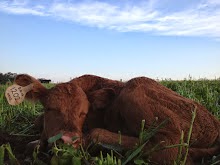From NPR

Scientist Robert Koch holding a post-mortem on an ox thought to have died of rinderpest, circa 1900.
Twice in all of history, humans have managed to eradicate a devastating disease. You've heard of the first one, I suspect: smallpox. But rinderpest?
That's a German word for "cattle plague" a feared companion of cattle throughout history. When outbreaks occurred, as in Europe of the 1700s or Africa in the 1880s, entire herds were wiped out and communities went hungry. Now the disease is gone, eliminated from the face of the earth.
In this week's issue of the journal Science, several of the architects of rinderpest's elimination lay out the reasons for their success. The key innovation wasn't technological, they say. It was social and cultural.
Technology certainly played a part. Half a century ago, a British veterinarian named Walter Plowright, working in Kenya, created the first truly effective and safe vaccine for rinderpest. Mass vaccinations of cattle soon eliminated the disease from Europe and most of Asia. (Rinderpest never made it to North America or Australia; any infected cattle died before they finished the voyage.) Later, Jeffrey Mariner of the Tufts Cummings School of Veterinary Medicine, developed a version of the vaccine that didn't need to be refrigerated, allowing veterinarians to use it far from roads and electricity.
Yet the disease persisted in Africa, surviving in remote areas plagued by weak government and chronic conflict, such as southern Sudan and parts of Uganda, Ethiopia, and Somalia. Veterinarians rarely ventured into those areas, and it was hard to know where vaccinations were even needed because government officials were reluctant to report outbreaks.
Mariner, who now works at the International Livestock Research Institute in Kenya, says that ultimately, the skills and knowledge of nomadic cattle herders who lived in those hard-to-reach areas were the keys to cracking the rinderpest puzzle.
"Those farmers could tell us where outbreaks were occurring," Mariner tells The Salt, speaking by phone from Nairobi. In addition, some nomadic farmers got training as "community animal health workers" and were able to carry out vaccinations themselves. They proved better at the job than veterinarians, in part because they knew their animals.
This success, in fact, created another problem for the eradication effort, because it threatened the status of professional veterinarians. "It threatened the core of their livelihood," says Mariner. "Here you come and say, 'Somebody else can do this better than you.'"
Veterinarians had the power to shut the whole program down. So a key to the campaign was solving that political problem by giving both professionals and local farmers important roles that rewarded them for success.
Tom Olaka, a community animal health worker in the border region between Uganda, Sudan, and Kenya, identified and reported the last outbreak of rinderpest in 2000. The virus was officially declared extinct last year. Around the world, cattle farmers can breathe just a little easier.

You're welcome! Fascinating stuff--I LOVE NPR!
ReplyDelete